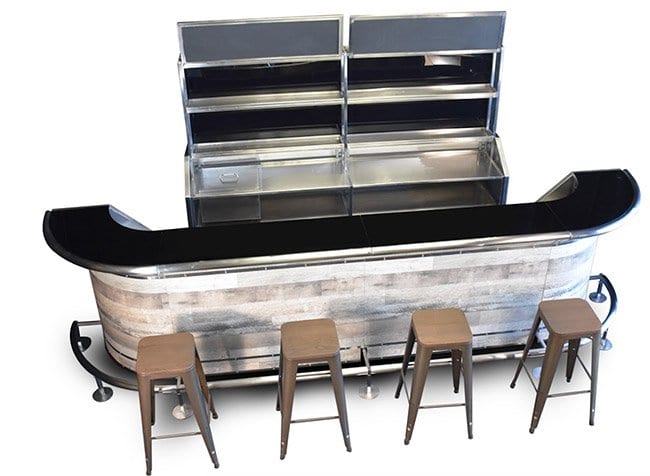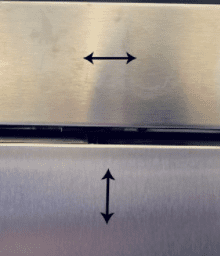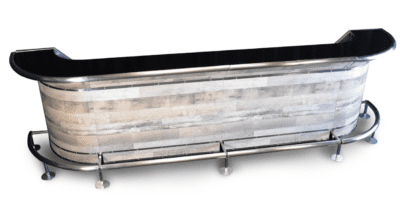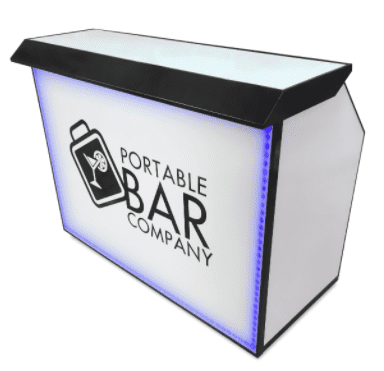
Regular Maintenance for Portable Bars
When a portable bar sees regular use, it needs maintenance to keep it in good condition. Periodically, owners should dust off and wash their portable bar to prevent dirt and debris from building up. The interior also needs some maintenance to keep it in good working order.
Exterior Care
Dusting a portable bar with a soft cloth once or twice a month is usually enough to keep it dust free. Every few months, it is a good idea to wash the bar with a mild soap and water. This helps to remove grease and any built up dirt before it causes damage to the panels or frame. Most of our bars come with or have an optional cover that helps to keep the exterior of the bar clean between uses.
Interior Care
Debris accumulated from serving drinks, as well as simply from being open, can collect inside on the working surface and frame of the portable bar. Owners should use mild soap and water to clean debris out of the interior of the portable bar.
Caring for the Panels on Your Portable Bar
The panels on a your portable bar are either laminate or acrylic and something that owners want to protect. If you have custom laminate panels, all that’s needed is regular washing.
Laminate Panels
To clean the surface, use a damp cloth or sponge and a mild soap or detergent. Rinse thoroughly with warm water and wipe dry. DO NOT USE BLEACH! It may cause discoloration. See the full laminate care document here.
Acrylic Panels
If you have acrylic panels, besides regular washing, you can polish your panels much as you would a car. Owners can apply polish or wax by hand after a thorough cleaning to remove minor scratches and scuffs. Once waxed, the portable bar panels are easier to clean regularly since dust and dirt are less likely to cling to the acrylic. Haziness, which is caused by age, exposure to the sun or cleaning with the wrong products, can be minimized or eliminated by careful sanding with a series of grits followed by buffing with a plastic polish. For step-by-step instructions on removing hazing, go to “How to Remove Haze from Plexiglas.”
Dealing with Scratches and Scuffs on a Portable Bar Frame
Occasionally owners may find that their portable bar has gotten a scratch or scuff during regular use. The paint used on a portable bar frame is thick, so scratches and scuffs, if not too deep sometimes can be removed with a bit of rubbing compound or even a buffing pad. For scratches that are down to the bare metal underneath the paint, owners must use touch up paint to repair the damage.
Portable Bar Part Maintenance
The portable bar Company manufactures a wide range of portable bars to meet different needs. Here are some portable bar maintenance tips that apply to various items on our portable bars.
Part |
Maintenance |
|
Casters |
If swivel assembly is loose, it may need to be replaced. If caster has a king bolt nut, make sure it is securely fastened. If swivel assembly does not turn freely, check raceways for corrosion or dirt. If equipment has rigid casters at one end, make sure caster housing/rig is not bent.
|
|
Wheels |
Check for visible points of wear. Flat spots may indicate foreign material, such as string, thread, etc., causing wheels to bind. Thread guards will delay build-up of such materials. Loose casters or frozen wheels are the other causes of this problem. Replace wheel and/or caster to avoid erratic rolling. After inspecting and making corrections, be sure axle nut is properly tightened. Use lock washers or nuts on all axles. Tighten loose axle immediately to avoid becoming cocked in the caster housing/rig and locking up. Keep replacement wheels and bearings on hand to avoid costly downtime. |
|
Frame Fasteners |
Tighten loose bolts and nuts and look for broken welds. Look for frame distortion due to overloads or impact loads. A distorted frame can cause premature wheel failure because of abnormal loads on one or two casters. Make sure the legs of the equipment are not bent and mounting bolts are properly secured. Always use lock nuts or lock washers with ll fasteners. |
Stainless Steel |
Just like wood, stainless steel also has a grain. These are the very faint striations that can be found on the surface of your appliance. An entire sheet of steel will have the same direction grain.
|
|
Laminate Panels |
To clean the surface, use a damp cloth or sponge and a mild soap or detergent. Rinse thoroughly with warm water and wipe dry. DO NOT USE BLEACH! It may cause discoloration. See the full laminate care document here. |
|
Acrylic Panels |
The best way to clean acrylic is with mild soap and water or a specialty plastic acrylic cleaner such as Novus No.1 or Brillianize. NEVER use window cleaning fluids with ammonia (such as Windex or Formula 409), gasoline, denatured alcohol, carbon tetrachloride, or acetone, which will cause the acrylic to craze with minute cracks. A mild solution of soap or detergent and water can also be used safely.
Begin by gently blowing away any loose dust or dirt from the acrylic’s surface. Apply the specialty cleaning product (or soap and water solution) with a dampened non-abrasive/non-contaminating/lint-free soft cloth, microfiber cloth or cellulose sponge. Rinse well with clear, clean water. Blot dry with a chamois, damp cellulose sponge or microfiber cloth to prevent water spotting. |
All of these maintenance tips are recommendations. We are not liable for any damage caused by any preventative maintenance outlined in this post. Some of the procedures require specialized knowledge and damage may be caused to the bar if performed improperly. Primarily the removal of scratches in the panels or frame.

